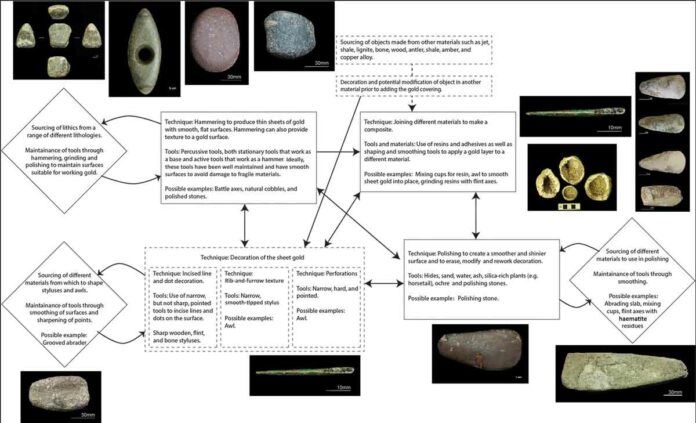There are many grave goods at the important Bronze Age burial near Stonehenge. Archaeologists had discovered a 4000-year-old goldworking toolkit from there.
The toolkit was discovered during the excavation of the Upton Lovell G2a Bronze Age burial in 1801. It is now on display at the Wiltshire Museum in Devizes. Researchers from the University of Leicester, in collaboration with experts from the University of Southampton, have now re-examined the stone and copper-alloy grave goods discovered with the burial. The study has revealed that they are goldworking tools.
Dr. Christina Tsoraki of Leicester conducted a wear analysis on grave goods at the Devizes Museum. It was a part of the ‘Beyond the Three Age System’ project. Tsoraki noticed what appeared to be gold residues on their surfaces during the process. It was also clear that the stone tools had been used for a variety of purposes. These purposes include hammers and anvils and others were used to smooth other materials.
Dr. Tsoraki’s discoveries inspired the team to collaborate with Dr. Chris Standish, an expert in Early Bronze Age goldworking and Dr. Richard Pearce, a Scanning Electron Microscopy specialist. They both are from the University of Southampton. They examined the residues with a Scanning Electron Microscope and an Energy Dispersive Spectrometer to confirm the identification. They wanted to determine whether the residues were ancient or modern.
Their findings were published in the journal Antiquity. The study confirmed the presence of gold residues on five artifacts. They also discovered that these residues have an elemental signature that matches that of Bronze Age goldwork found throughout the UK.
The Upton Lovell G2a burial had already earned a special place in archaeological history. It is marked by an earthen mound and is located near Stonehenge. Two people were buried at the site with a variety of grave goods. Goods including a large number of perforated bone points. These are thought to have been part of an elaborate costume. These objects were previously on display at the British Museum as part of the landmark ‘World of Stonehenge’ exhibition. But they are now back on display in Wiltshire.
Dr. Colin Shell’s research in the 2000s discovered possible gold traces on one of the stone grave goods. This new study has now discovered four more stone objects with gold on their surfaces and distinctive wear traces. The study has connected a broader range of items from burial to the goldworking process. It also demonstrates the age of these gold traces. The tools were allegedly used to create multi-material objects. Objects like jet, shale, amber, wood, or copper and decorated with a thin layer of gold sheet.

